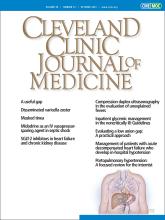Table of Contents
From the Editor
- A useful gap
A very low anion gap can suggest a laboratory measurement error or provide a clue to clinically important protein abnormalities or ingestions that warrant specific investigation.
The Clinical Picture
- vOka vaccine-associated disseminated varicella zoster
The patient had received the live attenuated vaccine 1 month before presentation. He had no history of varicella infection.
1-Minute Consult
- Should midodrine be used as an intravenous vasopressor-sparing agent in septic shock?
Research and robust data are still lacking regarding use of midodrine in this setting.
- Should I start an SGLT-2 inhibitor in my patient with heart failure and chronic kidney disease?
These conditions often co-exist and can have complex interactions. The progression of kidney disease increases the risk of major adverse cardiovascular events.
- Should you use compression duplex ultrasonography to detect deep vein thrombosis to evaluate unexplained fevers?
The authors provide recommendations on when to order imaging of the extremities in the evaluation of hospitalized patients with unexplained fever.
Guidelines to Practice
- Inpatient glycemic management in noncritically ill patients: Updated guidelines
The guidelines include a role for newer diabetes technologies and nontraditional insulin and noninsulin therapies.
Review
- Evaluating a low anion gap: A practical approach
In teaching and in practice, little attention is given to a low anion gap, an oversight that can result in a missed opportunity to diagnose acute or chronic disorders requiring treatment.
1-Minute Consult
- What is the most appropriate management of patients with acute decompensated heart failure who develop in-hospital hypotension?
The authors offer a tailored approach to risk-stratification in these patients that focuses on early recognition and management of symptomatic and clinically significant hypotension.
Review
- Portopulmonary hypertension: A focused review for the internist
Key aspects of screening, diagnosis, and treatment, and a review of the various pulmonary hemodynamic patterns encountered in patients with liver disease.




